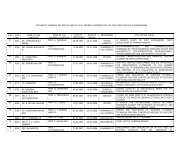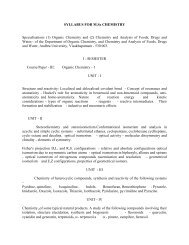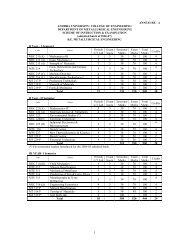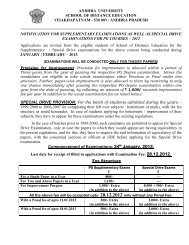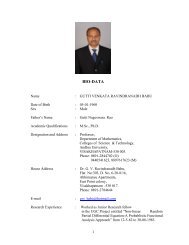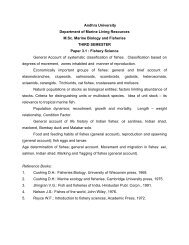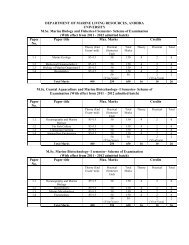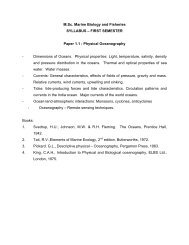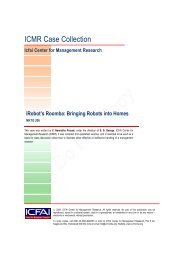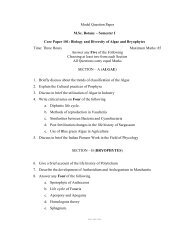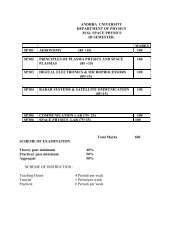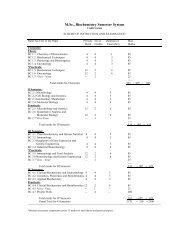M.Sc Hydrology - Andhra University, Visakhapatnam
M.Sc Hydrology - Andhra University, Visakhapatnam
M.Sc Hydrology - Andhra University, Visakhapatnam
Create successful ePaper yourself
Turn your PDF publications into a flip-book with our unique Google optimized e-Paper software.
HS-201 GEOLOGY II<br />
UNIT I: Objectives of structural geology-composition and resolution of forces-stress, strain.<br />
Description of folds. Classification, mechanics and causes of folding. Foliation and<br />
lineation. Classification of faults, brittle and ductile structures, shearing and shear zones.<br />
Classification of unconformities. Map patterns and their uses in determination of large<br />
scale structures. Tectonic evolution of Dharwars, Eastern Ghats, Aravalis, Singhbhum<br />
and Cuddapahs. Evolution of Himalayas and tectonics. Outlines of geological mapping.<br />
UNIT II: Earth and stratified rocks-importance of stratigraphy-geological cycle and time scale.<br />
Stratigraphic nomenclature and classification. Sargur, Dharwar, Singhbhum super<br />
groups, Aravalis and Eastern Ghat Mobile Belts, Cuddapahs, Vindyan and Kurnool<br />
systems, Deccan basalts, Cretaceous formations, and quaternary formations- boundary<br />
problems in stratigraphy.<br />
UNIT III: Geochemical cycle, geochemical exploration methods, classification of elements.<br />
Analytical techniques for geochemical analysis. Outlines of standards preparation.<br />
Instruments and their exposure. Elements of ore petrology, characteristic features and<br />
genesis of ferrous and non-ferrous ore deposits of India. Mettalogeny, origin, migration<br />
and entrapment of petroleum deposits. Properties of source and reservoir rocks.<br />
Petroliferous basins of India- an outline. Classification of coal, ranking, and grading of<br />
coal deposits of India.<br />
UNIT IV: Physiography and divisions of seas and world oceans. Properties of sea water-salinity,<br />
temperature, density. Littoral and sublittoral zones. Continental shelves, slopes, deep<br />
sea, aprons, seamounts and guyots, abyssal plains- Mid ocean ridge system, aseismic<br />
ridges. Coral reefs and their formation. Tectonic domains of oceans, island arcs, trenches,<br />
hotspot mechanism. Turbidity currents and deep sea sediments, placers on the beach and<br />
shelfs, conditions for formation of polymettalic nodules. Law of the seas.<br />
UNIT V: Orogency-continental drift hypothesis-breakup of continents-plate tectonics-convergent<br />
and divergent margins, eustatic changes of sea level, lithosphere. subduction, obduction<br />
and benioff zones, plate margins, mineralisation near plate margin, major and minor<br />
plates. Transform and transcurent faults, driving mechanism of the plates, convection<br />
currents, triple junction, movement of Indian subcontinent. Origin and evolution of life,<br />
fossils and their uses. Biomineralisation studies on fossils, pale ecology, oxygen and<br />
carbon isotopic studies on fossils, and analysis of paleontoiogical record for tracing plate<br />
tectonic process.<br />
Books :<br />
1. Sub marine geology, P.H.Kunen<br />
2. Submarine geology, F.P.Sheppard.<br />
3. Stratigraphy of India, M.S.Krishnan<br />
4. Structural Geology, M.P.Billings<br />
5. Geochemistry, Rankama and Sahama<br />
6. Economic mineral deposits, A-M.Bateman and M.N.Jenson<br />
7. Aspects of Tectonics, focus on south central India, K.S.Valdiya



